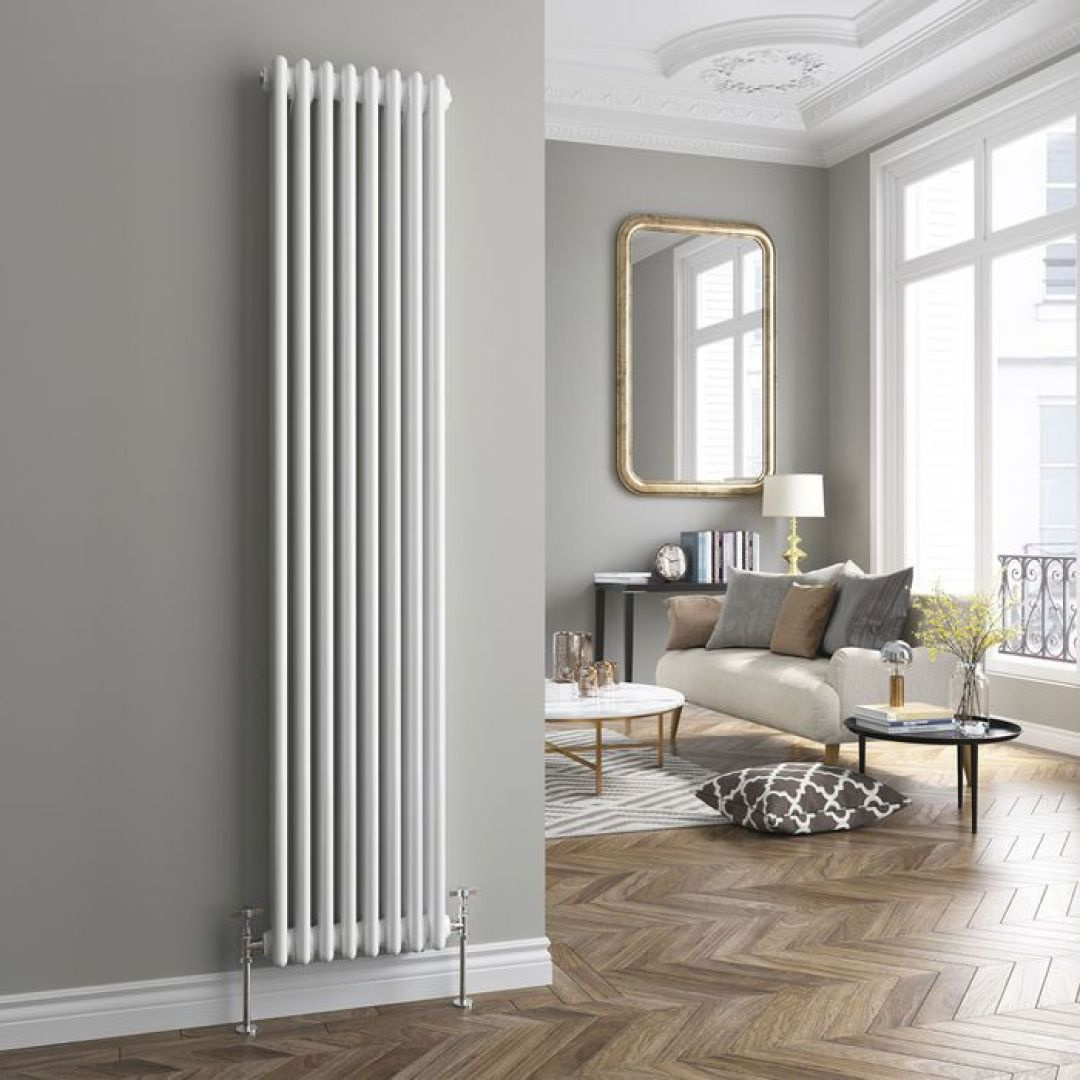
In the narrative of home design, the cast iron radiator is a protagonist. It is a piece of functional sculpture, a heavyweight anchor of history and style that commands a room. We fixate on its form: the elegant curve of a “schoolhouse” design, the intricate floral scrollwork of a Victorian reproduction, the raw, industrial honesty of a multi-column giant. We debate finishes, agonising over a classic, crisp white, a dramatic anthracite grey, or a bold, hand-burnished metallic. But beneath this beautiful, heavy armour lies a heart that beats in a language we often ignore. This language is not spoken in aesthetics; it is spoken in numbers. It is the language of the British Thermal Unit (BTU), and it is the single most important, non-negotiable factor in your entire radiator project.
Choosing a radiator based on its looks alone is like buying a car for its paint job without ever checking what engine is under the hood. The consequences of this mistake are not minor. They are not a small inconvenience. Getting the BTU calculation wrong is a fundamental failure that can lead to a lifetime of discomfort, inefficiency, and financial regret. An underpowered system will leave you in a state of perpetual chill, forcing your boiler to run constantly in a futile attempt to heat a space it was never equipped to handle. An overpowered system is just as bad, creating a stuffy, oppressive environment that “short-cycles” your boiler, wasting energy and wearing out components. Before you fall in love with a design, you must first do the maths. This guide is your blueprint for ensuring the engine you choose is perfectly tuned for the home you are creating.
The Unseen Engine: Why a BTU is More Than Just a Number
So, what is this invisible force we are trying to master? A single British Thermal Unit (BTU) is the amount of energy required to heat one pound of water by one degree Fahrenheit. In the world of heating, a radiator’s BTU rating is its power output. It is a direct measure of its ability to introduce heat into a space. Understanding the British Thermal Unit (BTU) is the single most important step in any heating project. It is the language of heat. When you are planning to invest in cast iron radiators, you are investing in a lifetime of comfort, and that comfort is dictated by this number. “Close enough” is a guess, and guessing with a permanent, plumbed-in fixture is a recipe for expensive, long-term disappointment. The goal of a heating system is not just to “get hot,” but to achieve a perfect, stable equilibrium, a state where the heat being introduced by the radiator exactly matches the heat being lost by the room to the outside world.
When you under-calculate, this equilibrium is never reached. Your beautiful, expensive cast iron radiator will get hot to the touch, but the room itself will remain stubbornly cold. This is because the radiator’s total output is simply not enough to combat the rate of heat loss through the walls, windows, and floor. The result is a system in chaos. Your boiler will fire continuously, working at maximum capacity for hours on end, desperately trying to help the undersized radiator reach the temperature on the thermostat. This is the very definition of inefficiency. You are paying for a full-throttle heating system but only receiving a lukewarm, draughty room. This constant operation also puts immense strain on your boiler, shortening its lifespan. With cast iron, the failure is even more tragic. The material’s greatest strength is its thermal mass—its ability to get warm and stay warm, radiating a gentle, enveloping heat. An undersized unit never gets to “cruise;” it is always in a state of emergency, failing to provide the very comfort you bought it for.
The other side of the coin, over-sizing, is just as problematic. A radiator that is far too powerful for the space acts like a sledgehammer. The thermostat clicks on, and this oversized beast blasts the room with a tidal wave of heat. The room temperature spikes, shooting past the desired setting and becoming stuffy and uncomfortable. The thermostat, detecting this spike, immediately shuts the boiler off. The room then begins to cool, and the cycle repeats. This is known as “short-cycling.” It is jarring, inefficient, and wildly uncomfortable. It is the opposite of the gentle, stable, radiant warmth that cast iron is meant to provide. Getting the BTU calculation right is the only way to unlock that signature comfort. It is the invisible blueprint that ensures your radiator and your room will work in perfect, silent harmony.
The Anatomy of a Cold Room: Factors Beyond Simple Measurements
The internet is awash with “simple” BTU calculators. They ask for three things: the length, the width, and the height of your room. You plug in the numbers, and it spits out a result. This is, without question, the most common and most dangerous mistake a homeowner can make. These calculators are not just “simple;” they are dangerously incomplete. They operate on the assumption that your room is a perfectly sealed, insulated, average-sized box. The reality is that no home is a simple box. Every room has a unique thermal personality, a complex profile of weaknesses and strengths that dictate how it loses heat. A true calculation must account for this. It is not just about the volume of the room; it is about the fabric of the building.
The single biggest variable is heat loss through the building’s envelope. A room in a brand-new, well-insulated timber-frame house might need half the BTUs of the exact same-sized room in a 19th-century Victorian terrace with solid brick walls. Those solid walls have very little insulating property and act as a “thermal bridge,” constantly sucking warmth from the inside and releasing it to the outside. Your calculation must account for this. The next, and most significant, culprit is glazing. Windows and doors are, thermally speaking, holes in your home’s armour. A room with a large, beautiful, single-glazed sash window is a thermal disaster. It is a waterfall of cold air. A modern, triple-glazed, argon-filled window, by contrast, is an excellent insulator. A calculation that does not ask what kind of windows you have, and how many, is not a calculation; it is a guess. A large, north-facing bay window, for example, can single-handedly double the heating requirement of a room.
The room’s position on the compass is also a critical factor. A south-facing room benefits from “solar gain” throughout the day, essentially receiving free heat from the sun. A north-facing room, however, receives no direct sunlight. It is in a constant state of thermal shadow and will be inherently colder, requiring a significant percentage increase in your BTU target. You must also consider what is above and below. Is the room over a cold, uninsulated cellar or garage? You must add BTUs. Is it a living room with a bedroom above it? That is a more stable, insulated environment. Is it a top-floor room with a poorly insulated attic? The heat will escape straight up. Each of these factors adds or subtracts from your final target. A simple volume calculation misses all of this nuance, and in doing so, sets you up for failure.

A More Honest Calculation: How to Find Your True BTU Target
Now that we understand the “why,” we can address the “how.” While the gold standard will always be a professional heat-loss survey from a qualified heating engineer, you can get a far more accurate estimate than any simple online calculator by following a more detailed, multi-step process. This process is about establishing a baseline and then applying “adjustment factors” based on your room’s specific weaknesses.
First, you must still find the volume of your room in cubic metres. Measure the length, width, and height (e.g., 5m x 4m x 2.5m = 50 cubic metres). Next, you apply a baseline multiplier based on the purpose of the room, as this dictates the desired comfort level. A living room or bathroom, where you want consistent, enveloping warmth, requires a higher factor (e.g., 50). A bedroom, which is often cooler, requires a lower factor (e.g., 40). A transitional space like a hallway might only need a factor of 30. For our example, a 50-cubic-metre living room would have a baseline need of (50 x 50) = 2500 BTUs.
This 2500 BTU figure, however, is the starting point, not the answer. This number assumes you live in a modern, well-insulated home. Now, we must apply the adjustment factors for heat loss. You must be honest about your home’s construction. Does the room have solid, uninsulated walls? You must add 20-30% to your BTU target. Does it have two or more external walls (i.e., it is a corner room)? Add 15%. Now, look at the windows. If you have standard double-glazing, your baseline is likely fine. But if you have single-glazed windows, you must add at least 20% to your total. If that single-glazing is a large bay window, you might need to add 30% or more. Finally, consider the position. If the room is north-facing, add 10-15%.
Let us re-calculate our example. The 2500 BTU living room has single-glazed windows (add 20%, which is 500 BTU) and is north-facing (add 15%, which is 375 BTU). Your true target is no longer 2500 BTU. It is 2500 + 500 + 375 = 3375 BTUs. The simple calculator was almost 1000 BTUs short. This is the “Don’t Get it Wrong” moment. This 3375 BTU figure is the “engine” you must go shopping for. It is the number that dictates the size, shape, and type of radiator you need.
From Target to Radiator: Spending Your BTU “Budget”
Once you have this precise, non-negotiable BTU target, the process becomes wonderfully creative. You now have a “budget” of heat to spend, and you can configure your radiator to deliver it in a way that perfectly suits your room’s layout and your aesthetic vision. This is where the beauty of cast iron truly shines. Reputable suppliers do not just sell radiators in “small, medium, or large.” They provide detailed BTU outputs per section for every single style and height they offer. This allows you to “build” your perfect radiator.
Let us say your target is 3375 BTUs. You are not looking for a radiator; you are looking for a combination of sections that adds up to that number. You have complete control over the geometry. If you have a long, low wall under a window, you could choose a low-profile, 4-column radiator. If each section of that style provides 150 BTUs, you would simply divide your target (3375 / 150) to find you need approximately 22-23 sections. This would give you a long, low, and perfectly-powered radiator that creates a warm curtain of air along your window.
But what if you have no space under the window? What if your only available wall is a narrow strip between two doorways? You can still hit your target. You would simply choose a taller radiator, perhaps a 6-column model. A tall, 6-column section might provide 300 BTUs. You would then only need (3375 / 300) = 11-12 sections. The result is a tall, narrow, and visually dramatic radiator that delivers the exact same amount of heat. This is the ultimate freedom of the “made to order” process. The BTU calculation does not limit your design choices; it empowers them. It allows you to select any style you want, confident that the final, assembled product will be perfectly and precisely engineered to keep your room comfortable for a lifetime.
Conclusion: The Invisible Blueprint for a Lifetime of Comfort
In the end, a cast iron radiator is a lifetime investment. It is a piece of your home’s architecture, an heirloom that will likely outlast the boiler that powers it and the very walls it is fixed to. Its visual appeal is what draws you in, but its thermal performance is what you will live with, day in and day out, for decades. To ignore the BTU calculation is to gamble with that future, to risk turning a beautiful object into a cold, inefficient, and expensive monument to a simple mistake.
The calculation is the invisible blueprint. It is the physics that underpins the poetry. Taking the time to go beyond the simple calculators, to honestly assess your home’s unique thermal challenges, and to arrive at a precise, accurate BTU target is the most important step in the entire process. It is the foundational act of diligence that unlocks everything else. It ensures that your boiler will run efficiently, that your energy bills will be manageable, and that your home will be filled with the one thing you were seeking from the very beginning: a steady, silent, and truly enveloping warmth.





